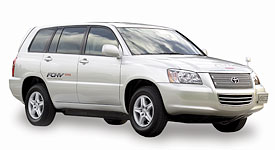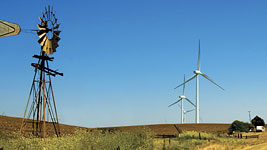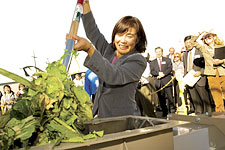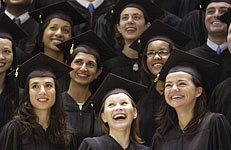Volume 26 · Number 1 · Fall 2008
100 Ways
that UC Davis Has Transformed the World
Science and engineering
Speedy Net.
UC Davis electrical engineers have invented communications network switches that work with light pulses instead of electrical signals. This technology could allow a 10,000-fold increase in the speed and capacity of Internet and telephone networks.

Pollution.
We know more about the health risks of the air we breathe, thanks to UC Davis studies on secondhand cigarette smoke and children, pollution from traffic and agriculture, and the Sept. 11 dust that coated Manhattan around Ground Zero. And vet school researchers in the 1970s developed tools used by the U.S. Environmental Protection Agency to set national air-quality standards.
Solar system origin.
UC Davis geologists have analyzed meteorites to set the most precise dates yet on the earliest stages in the birth of our solar system, when microscopic dust collected into mountain-sized clumps. They have also shown that Mars was covered in an ocean of molten rock for about 100 million years after the planet formed.

Transportation leadership.
UC Davis is a pioneer in plug-in hybrid electric cars. Researchers, particularly engineering professor Andrew Frank, have developed plug-in hybrids that recharge from a standard 110-volt electric outlet and can travel as far as 20 miles on batteries alone — or get 100 miles per gallon of gas. In addition, the UC Davis Institute of Transportation Studies, under the direction of Daniel Sperling, studies all types of alternative-fuel vehicles — from hybrids to hydrogen-powered — and shapes public policy on transportation issues ranging from new auto technology and emission reductions to consumer attitudes and studies.
Fuel standards.
The fuel you pump into your car or truck will be getting greener, thanks in part to the work of UC Davis professors. In January 2007, Gov. Arnold Schwarzenegger announced the world’s first low-carbon fuel standard for transportation fuels. It requires gasoline and diesel-fuel providers to reduce the carbon intensity of their products sold in California by 10 percent by year 2020 and more thereafter. Three UC Davis professors helped write this groundbreaking standard. In California, transportation fuels account for about 40 percent of all greenhouse-gas emissions.
AT&T Park.
San Francisco’s AT&T Park baseball stadium is less windy for fans and fly balls thanks to wind tunnel tests performed by UC Davis engineers on a model of the park before construction began. As a result, the final stadium was turned 90 degrees from the initial design to avoid wind problems.
Smart lighting.
Energy-saving lighting has been developed by the California Lighting Technology Center at UC Davis, one of the few design research centers in the nation doing such work. Its experts advance the use of light-emitting diodes (LEDs) in lamps, occupancy sensors in homes and parking garages, and daylighting in residential and business buildings.
Virtual “cave.”
Geologists can literally step inside their data — instead of into remote, inaccessible or dangerous places — at a virtual reality environment at UC Davis. The W.M. Keck Center for Active Visualization in Earth Sciences (KeckCAVES) allows researchers to see and work with their data in three dimensions, whether it’s a Martian rock or a computer model of the Earth’s interior.
DNA discovery.
UC Davis researchers have developed technology to watch a single enzyme that unwinds DNA at work in real time. They have used the technique to gain new insights into the molecular machines that copy and repair DNA, a vital process in living cells that, when it goes awry, can lead to cancer.
State water project.
Engineering work at UC Davis played a big part in the design of the 444-mile-long California Aqueduct and other elements of the State Water Project that today serves 23 million Californians and 755,000 acres of farmland. Jaime Amorocho and others built water project models in a laboratory that now bears his name and that is used today by scientists designing river pumps and other diversion works that are safer for fish like the endangered delta smelt.
Ideas to products.
From strawberry varieties to pet vaccines to telecommunications technology, inventions born at UC Davis are being turned into products and services. Since 1975, 41 new companies have been spun off from the campus, and the university holds a portfolio of 875 active patents, plant varieties and other intellectual property. In fiscal year 2006–07, UC Davis earned just over $8 million in royalties and fees from licensing inventions.

Wind power.
UC Davis engineers have developed software for modeling airflow that allows improved turbine design, while the California Wind Energy Consortium at UC Davis brings together industry, academia and government to advance the use of wind power. The center carries out research, organizes conferences and offers training courses on wind energy systems for technicians and the general public.
Earthquake safety.
The largest earthquake-simulation centrifuge in the U.S. — located at UC Davis’ Center for Geotechnical Modeling — has demonstrated what happens to soils and structures such as bridges, dams and BART tunnels during an earthquake. In addition, researchers are working to improve forecasts of the location and timing of future earthquakes — much like predictions of hurricane activity. They have started a company to further their work and provide forecasts to benefit emergency planners and the insurance industry.

Scanning the universe.
From a mountaintop in Chile, the planned Large Synoptic Survey Telescope will map the entire visible night sky every three nights for 10 years, in order to provide clues to the origins and structure of the universe. The project consortium, which includes universities, foundations and private sector companies, is led by UC Davis physics professor J. Anthony Tyson.
Voting integrity.
California election officials tightened security regulations for electronic voting machines in 2007 after government- commissioned teams, one of them led by a UC Davis computer scientist, hacked into models used in 43 of the state’s 58 counties. Many polling places reverted to paper ballots for the 2008 presidential primary.
Life’s signs.
If you want to know whether life ever existed on Mars or other planets, you need to know what its traces would look like. From remote Canadian lakes to Death Valley to the Australian Outback, UC Davis geologists are studying both fossils of some of the earliest living things and their present-day relatives to find the unique signatures of life.

From trash to gas.
One day food waste and yard trimmings may power our homes. The Biogas Energy Project is using silos of hungry bacteria to turn waste into methane and hydrogen, with the goal of producing enough energy from one ton of waste to fuel 10 California homes for one day.
Climate change.
For decades, UC Davis has been anticipating climate change and its impacts on agriculture, native plants and animals, and human health. Researchers here pioneered the now-ubiquitous use of stable isotopes in understanding global carbon and nitrogen cycles.

A world of alumni.
From the time the first students graduated in 1911, UC Davis alumni have been making their mark in the world — and beyond. Among their countless achievements are winning Olympic gold medals, directing Oscar-winning Disney films, heading UNICEF and flying through space as astronauts. With every year, the Aggie impact multiplies. From nine students in the 1911 class, our living alumni total has grown to 185,000.
« Return to 100 ways introduction

